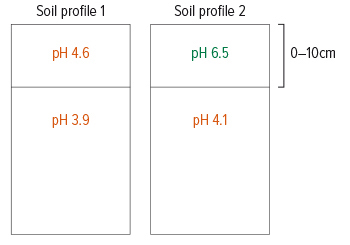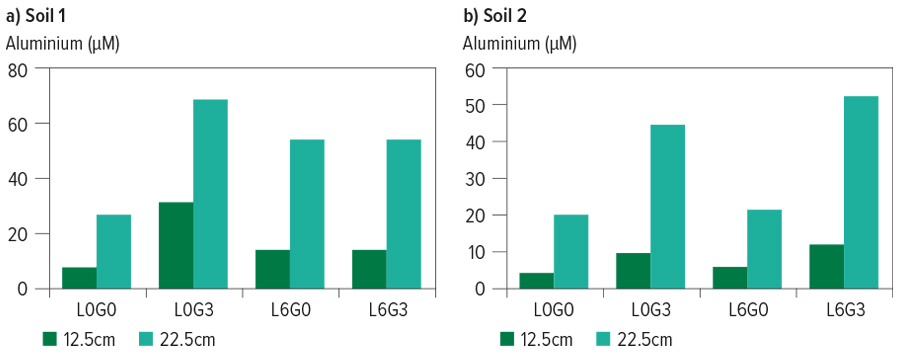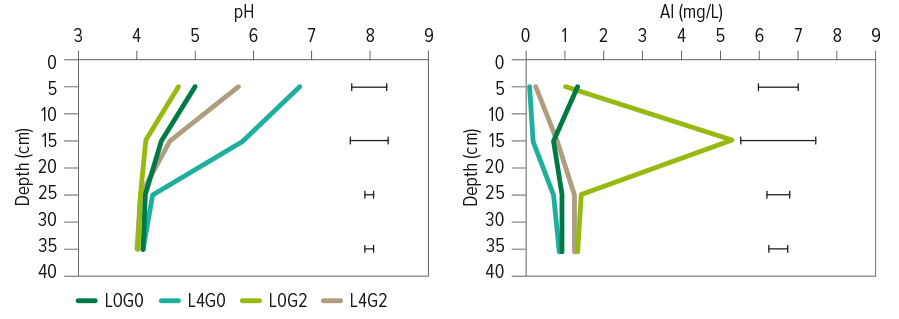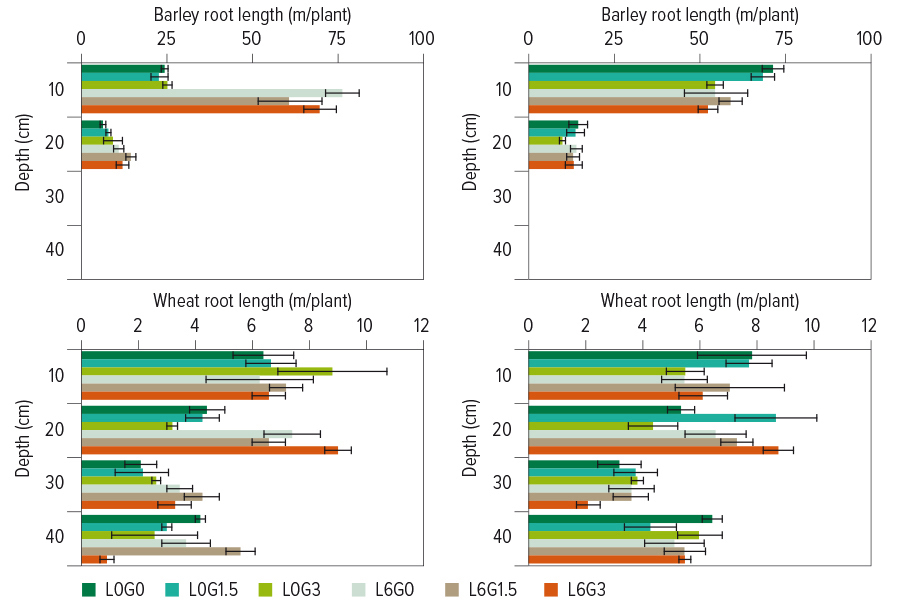The most effective way to tackle subsurface acidity is to physically mix a liming agent into the acid layers. As top-dressing lime and waiting for it to move deeper of its own accord takes years, and where lime cannot be mixed to depth or is considered too expensive when transporting long distances (usually because there is ‘cheaper’ gypsum nearby), some growers are looking at gypsum as an option to tackle subsoil acidity.
There are schools of thought that gypsum makes lime work better. As gypsum is more soluble than lime, some people think that gypsum and lime will move into acidic layers faster than lime alone, and that gypsum can counteract toxic aluminium.
Gypsum does not raise soil pH – numerous studies over the years have shown this. But gypsum can affect aluminium availability, and some trials have found that using gypsum on an acid soil might boost yield.
As research to date has been limited, there are multiple knowledge gaps. The mechanisms by which gypsum may be beneficial have not been tested under controlled conditions, nor have effects on root growth been measured in Western Australia.
To work out what is really going on in the root zone, glasshouse research at Northam, WA (DAW00252) is teasing out specific lime and/or gypsum effects on soil chemistry and root growth, without environmental or other factors muddying the waters. Field trials at Kalannie, WA, are investigating broader impacts such as yield.
The experiments
Glasshouse
Column trials compared historically unlimed (Profile 1) and limed soil (Profile 2) from an acidic soil at Merredin, WA (Figure 1). Soil was collected in 2017, and 18 treatments applied:
- three lime rates (zero, three and six tonnes per hectare; incorporated to 10 centimetres);
- three gypsum rates (zero, 1.5 and 3t/ha; top-dressed); and
- two watering rates (equivalent to 400 and 800 millimetres of rainfall/year).
Soil pH and aluminium were measured in 2017 and 2018, and in 2019 the columns were planted with aluminium-sensitive barley and grown until flowering. Roots were washed and measured, and total root length calculated.
 Figure 1: Merredin soil profiles. Soil profile 1 was not limed historically. Soil profile 2 was limed with 3t/ha in 2008 and 3t/ha in 2013.
Figure 1: Merredin soil profiles. Soil profile 1 was not limed historically. Soil profile 2 was limed with 3t/ha in 2008 and 3t/ha in 2013.
Field
Field trials on acidic soil at Kalannie grew wheat in 2017 and 2018, and canola in 2019.
The treatments – lime at zero, 2, 4 and 6t/ha, and gypsum at zero, 1, 2 and 3t/ha – were either top-dressed or incorporated with a one-way plough in early 2017.
Findings
pH and aluminium
By mid-2018 in the glasshouse trial, there was no significant change in subsoil pH (22.5cm depth), regardless of soil type, lime rate and rainfall. There was a general trend, though not statistically significant, of gypsum-treated columns having a slightly lower pH (0.1 to 0.3 pH units) with a corresponding increase in aluminium (Figure 2).
This:
- confirmed known lack of alkalinity movement from a higher pH surface layer (pH 6.5) into an acidic subsoil, even with 800mm of rainfall over one-and-a-half years;
- indicated lime, applied either alone or with gypsum, failed to move deeper than 20cm; and
- suggested that gypsum was moving into the subsoil and increasing aluminium in solution.

Figure 2: Aluminium levels tended to increase with higher gypsum rates.
In the Kalannie field trial, gypsum also lowered pH and increased aluminium in the soil solution (Figure 3).

Figure 3: pH and aluminium at Kalannie field trial.
Some research suggests that although measured aluminium increases with gypsum, it can be less of a problem to roots because sulfur in gypsum can bind to aluminium to form less-toxic aluminium sulfate. Gypsum also increases the ionic strength of the soil, which can reduce the relative activity of aluminium. However, in an acid soil, if gypsum reduces pH by just 0.1 units, toxic aluminium can double, reducing or negating any beneficial effect from gypsum in countering aluminium.
Root growth
While the effects of lime and gypsum on soil chemistry are intriguing, their effect on root growth is more practically relevant. As expected, in the glasshouse, mixing lime into the acidic topsoil (Figure 4, top left) had a significant positive effect on root growth of a sensitive barley in the top 10cm; roots were up to three times longer than the nil lime columns.
Gypsum, with or without lime, did not improve root growth. Barley plants in gypsum-treated columns often had a shorter total root length than nil gypsum columns (Figure 4). By flowering, barley roots did not grow below 20cm in any treatment.
The effect of lime and gypsum was less prominent on the root growth of Mace wheat (Figure 4, bottom). None of the treatments affected root growth of wheat in the top 10cm of soil. However, lime treated soil (with or without gypsum) enhanced wheat root growth in the 10 to 20cm depth of the subsoil. Being moderately tolerant to soil acidity, Mace wheat produced roots in all sampling depths but none of the treatments improved root growth in the deeper subsoil. Generally, previously limed soil had longer root systems in the subsoil (Figure 4, bottom right) compared to soil from the unlimed control plots (Figure 4, bottom left).

Figure 4: Root length in soil columns from unlimed plots (Profile 1, left) and limed plots (Profile 2, right). Top panels show barley root growth while bottom panels show wheat root growth.
Yield
In the field trials, gypsum effects were inconsistent and short-lived. Low rates of gypsum (1t/ha) significantly improved yield in 2017 (0.94t/ha, compared to control 0.81t/ha), but results were not repeated in 2018 or 2019. Higher gypsum rates caused a minor but not significant yield penalty.
Where gypsum alone improved yield, the measured data indicates it was unlikely to be due to acidity and/or aluminium effects. It was more likely a nutritional response, stemming from improved uptake of calcium and sulfur.
Lime and gypsum together had more favourable impacts on yield and soil chemistry than gypsum alone. Lime raised soil pH and lowered aluminium (Figure 3), while improving nutrient uptake. Gypsum supplied calcium and sulfur, and likely changed some of the aluminium into non-toxic forms. Yield generally increased with increasing lime rates, though lime at 2t/ha had the biggest impact on yield.
The takeaway
Research is continuing to better understand whether, and how, gypsum affects soil acidity, aluminium and root growth. In the meantime, results are showing:
- gypsum is not a substitute for lime to raise soil pH. It may slightly reduce pH;
- applying gypsum increases measured aluminium;
- it is very unlikely that gypsum helps lime move deeper or faster;
- lime and gypsum together do not improve root growth in acidic soil compared to lime alone; and
- gypsum alone does not improve root growth in acidic soil.
More information: Gaus Azam, gaus.azam@dpird.wa.gov.au
This article was produced as part of the GRDC ‘Maintain the longevity of soils constraints investments and increase grower adoption through extension – western region’ investment (PLT1909-001SAX). This project is extending practical findings to grain growers from the five-year Soil Constraints – West suite of projects, conducted by the Western Australian Department of Primary Industries and Regional Development, with GRDC investment.

























































